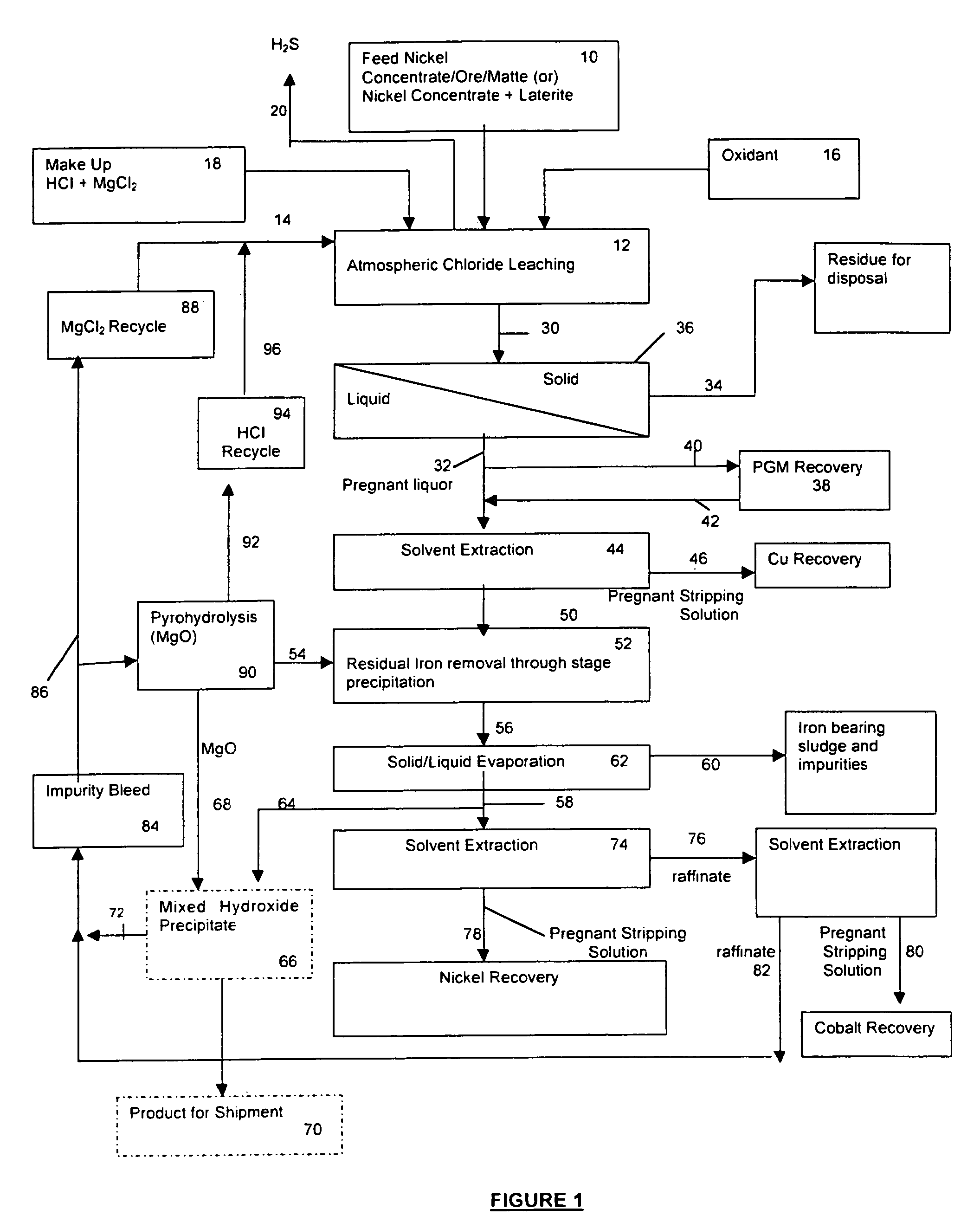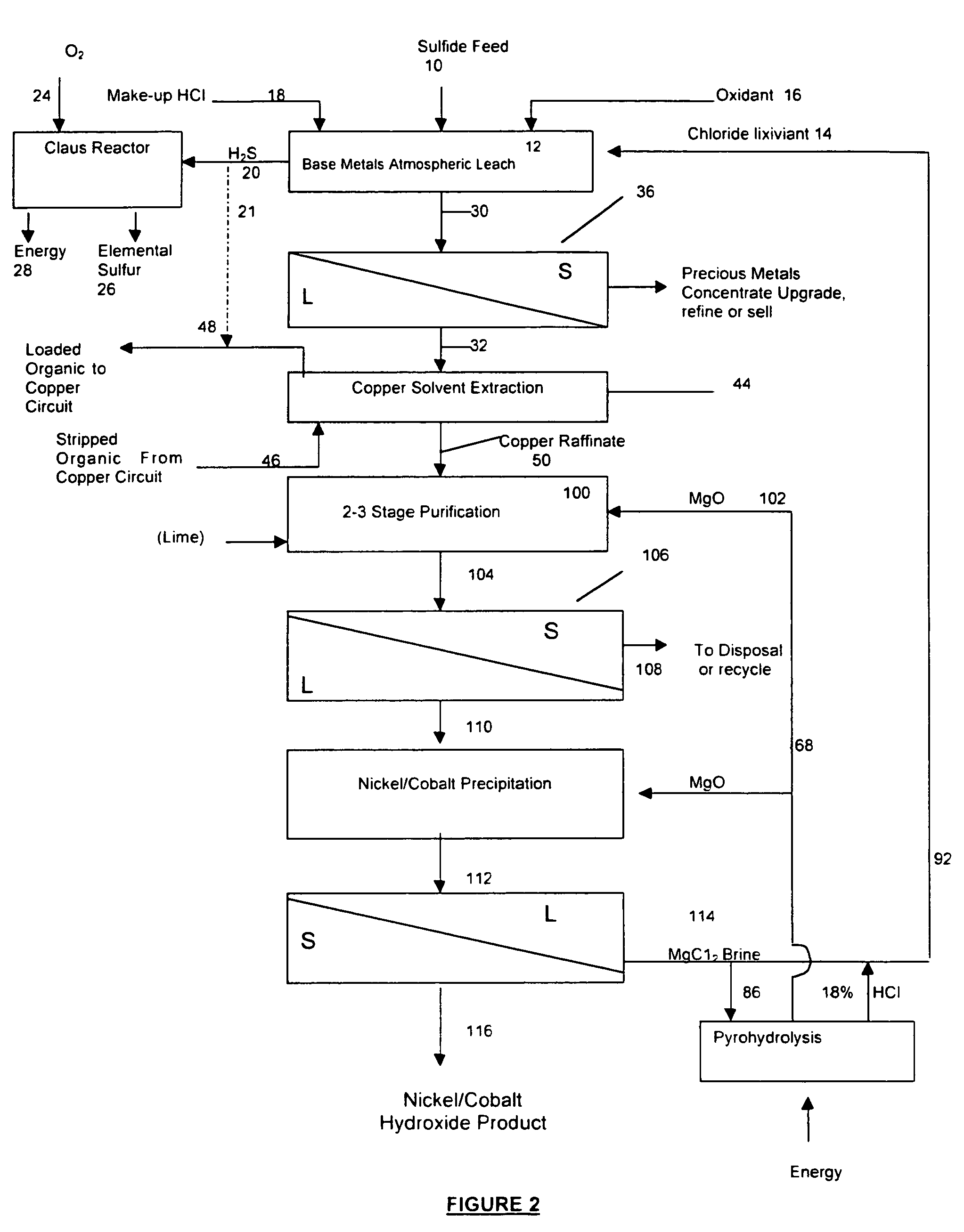Process for the recovery of value metals from base metal sulfide ores
a technology of value metals and sulfide ores, which is applied in the direction of solid separation, inorganic chemistry, dissolving, etc., can solve the problems of gold and pgms losing, and achieve the effect of simple gas/liquid
- Summary
- Abstract
- Description
- Claims
- Application Information
AI Technical Summary
Benefits of technology
Problems solved by technology
Method used
Image
Examples
example i
[0121]A series of comparative laboratory-scale leaching experiments were carried out using a base metal sulfide ore concentrate that was a mixture of pyrrhotite, pentlandite and chalcopyrite. The ore concentrate had the following analysis: Ni (18.65%), Cu (1.38%), Co (0.19%) and Fe (26.6%). The leach solution (approximately 500 mL) was a hydrochloric acid (2N in Runs 1 and 3, 4N in Run 2) solution containing 20 w / w of solids. Ferric chloride (FeCl3.6H2O) was added to each leach solution, so that the total chloride ion content (from HCl and ferric chloride) was 230 g / L. The temperature of the solution was 95° C. and the leaching time was 4 hours. The redox potential (Eh) was measured in mV. The pH was less than 0.
[0122]Oxidant was not added in Runs 1 and 2. In Run 3, chlorine gas was bubbled through the leach solution at a rate of 0.5 mL / min.
[0123]The leached solution was subjected to a liquid / solids separation step. The washed solids obtained were subjected to analysis for the conte...
example ii
[0127]In further comparative experiment, the procedure of Example 1 was repeated using 2N hydrochloric acid, except that for Run 4, the metal chloride was magnesium chloride (MgCl2.6H2O). The total chloride ion content was 300 g / L. The pH was <0.
[0128]The results obtained are given in Table II.
[0129]
TABLE IIRun 4Redox potential (Eh)410Ni extraction (solids)64Ni extraction (liquid)66Fe (solids)74Co extraction (liquid)58Cu extraction (liquid)79
[0130]The results show that the use of magnesium chloride (Run 4) improved the extraction of nickel from 47% to 66% as against Run 1, and was equivalent to ferric chloride and chlorine (Run 3) in the extraction of iron, cobalt and copper and slightly poorer in the extraction of nickel
example iii
[0131]The procedure of Example II was repeated, except that an oxidant was added to the leach solution, in order to illustrate aspects of the present invention. Thus, in each Run, the leach contained both magnesium chloride and an oxidant. The amounts, based on 500 mL of solution, are shown in Table III; chlorine was fed into the leach solution in the amount shown. In Run 5, the hydrochloric acid was 2N and the amount of total chloride ion concentration was 300 g / L. In Runs 6-9, the hydrochloric acid was 4N and the amount of total chloride ion concentration was 400 g / L. The pH was <0.
[0132]The results obtained are shown in Table III.
[0133]
TABLE IIIRun 5Run 6Run 7Run 8Run 9OxidantNaClO3NaClO3NaClO3NaClO3Cl2Amount of oxidant117 g0.25 g 0.5 g0.75 g 0.5 mL / minMgCl2•6H2O112 g 370 g370 g 370 g370 gRedox pot. (Eh)340 430440 420510Ni extrn. (solids) 54 95 96 92 98Ni extrn. (liquid) 57 78 86 88 92Fe (solids) 32 91 92 88 98Co extrn. (liquid) 55 90 88 85 96Cu extrn. (liquid) 64 48 28 ...
PUM
| Property | Measurement | Unit |
|---|---|---|
| temperatures | aaaaa | aaaaa |
| temperatures | aaaaa | aaaaa |
| redox potential | aaaaa | aaaaa |
Abstract
Description
Claims
Application Information
 Login to View More
Login to View More - R&D
- Intellectual Property
- Life Sciences
- Materials
- Tech Scout
- Unparalleled Data Quality
- Higher Quality Content
- 60% Fewer Hallucinations
Browse by: Latest US Patents, China's latest patents, Technical Efficacy Thesaurus, Application Domain, Technology Topic, Popular Technical Reports.
© 2025 PatSnap. All rights reserved.Legal|Privacy policy|Modern Slavery Act Transparency Statement|Sitemap|About US| Contact US: help@patsnap.com


